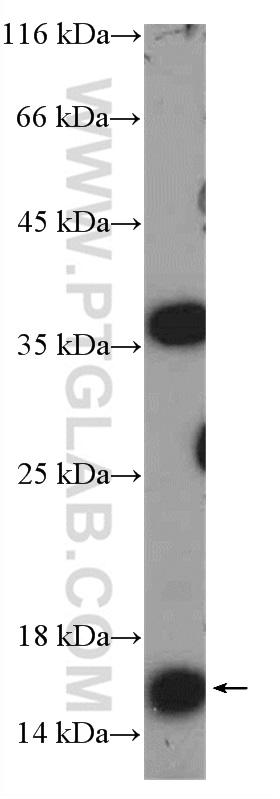验证数据展示
经过测试的应用
| Positive WB detected in | COLO 320 cells |
推荐稀释比
| 应用 | 推荐稀释比 |
|---|---|
| Western Blot (WB) | WB : 1:200-1:1000 |
| It is recommended that this reagent should be titrated in each testing system to obtain optimal results. | |
| Sample-dependent, Check data in validation data gallery. | |
发表文章中的应用
| WB | See 1 publications below |
产品信息
15196-1-AP targets MED10 in WB, ELISA applications and shows reactivity with human, mouse, rat samples.
| 经测试应用 | WB, ELISA Application Description |
| 文献引用应用 | WB |
| 经测试反应性 | human, mouse, rat |
| 文献引用反应性 | human |
| 免疫原 | MED10 fusion protein Ag7336 种属同源性预测 |
| 宿主/亚型 | Rabbit / IgG |
| 抗体类别 | Polyclonal |
| 产品类型 | Antibody |
| 全称 | mediator complex subunit 10 |
| 别名 | L6, MED10, mediator complex subunit 10, NUT2, TRG 17, TRG 20, TRG17, TRG20 |
| 计算分子量 | 16 kDa |
| 观测分子量 | 16 kDa |
| GenBank蛋白编号 | BC003353 |
| 基因名称 | MED10 |
| Gene ID (NCBI) | 84246 |
| RRID | AB_2878117 |
| 偶联类型 | Unconjugated |
| 形式 | Liquid |
| 纯化方式 | Antigen affinity purification |
| UNIPROT ID | Q9BTT4 |
| 储存缓冲液 | PBS with 0.02% sodium azide and 50% glycerol , pH 7.3 |
| 储存条件 | Store at -20°C. Stable for one year after shipment. Aliquoting is unnecessary for -20oC storage. |
背景介绍
MED10, also named as L6, TRG17, or TRG20, is a 135 amino acid protein, which belongs to the Mediator complex subunit 10 family. MED10 localizes in the nucleus and as a component of the Mediator complex, a coactivator is involved in the regulated transcription of nearly all RNA polymerase II-dependent genes. Multiprotein mediator complex acting as a coactivator is required for activation of RNA polymerase II transcription by DNA bound transcription factors.
实验方案
| Product Specific Protocols | |
|---|---|
| WB protocol for MED10 antibody 15196-1-AP | Download protocol |
| Standard Protocols | |
|---|---|
| Click here to view our Standard Protocols |
